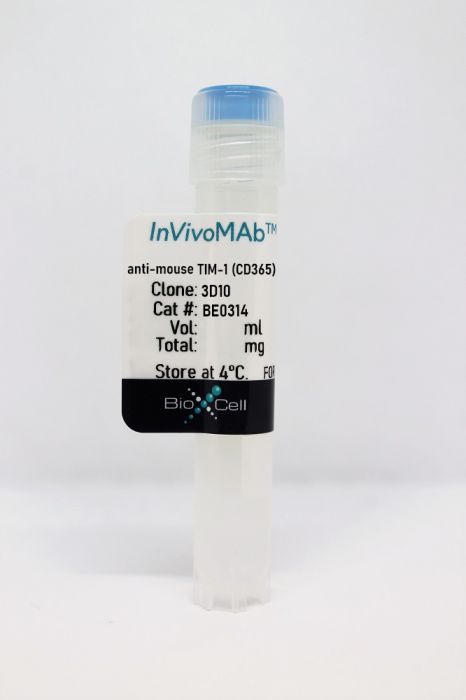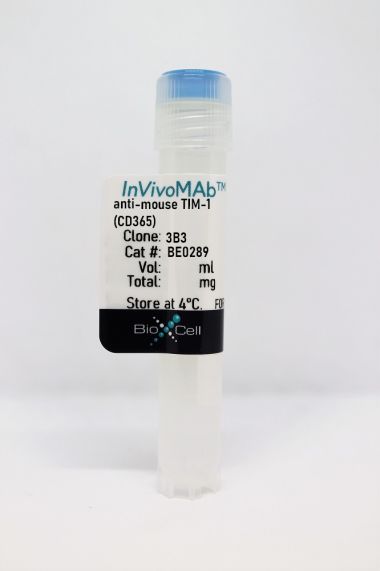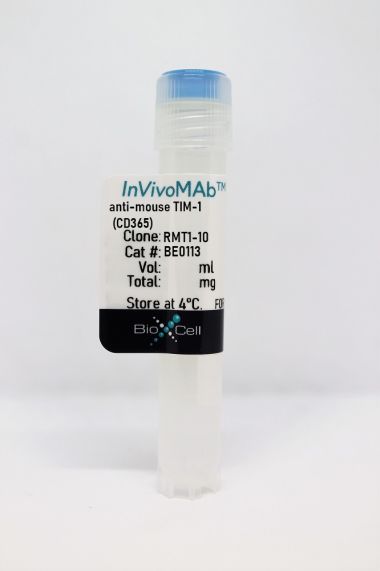InVivoMAb anti-mouse TIM-1 (CD365)
Product Details
The 3D10 monoclonal antibody reacts with mouse T cell immunoglobulin and mucin domain 1 (TIM-1) also known as CD365. TIM-1 is a type I cell-surface glycoprotein and member of the Ig superfamily. TIM-1 is preferentially expressed on TH2 cells and has been identified as a stimulatory molecule for T cell activation. The TIM gene family, plays critical roles in regulating the immune response to viral infection. TIM-1 is also involved in allergic responses, asthma, and transplant tolerance. The 3D10 antibody has been shown to block TIM-1 in vivo and enhance atherosclerosis in mice studies.Specifications
| Isotype | Rat IgG1, κ |
|---|---|
| Recommended Isotype Control(s) | InVivoMAb rat IgG1 isotype control, anti-horseradish peroxidase |
| Recommended Dilution Buffer | InVivoPure pH 7.0 Dilution Buffer |
| Conjugation | This product is unconjugated. Conjugation is available via our Antibody Conjugation Services. |
| Immunogen | Mouse TIM-1 (signal and IgV domains)/mouse IgG2a Fc fusion protein |
| Reported Applications |
in vivo TIM-1 blockade in vitro TIM-1 blockade |
| Formulation |
PBS, pH 7.0 Contains no stabilizers or preservatives |
| Endotoxin |
<2EU/mg (<0.002EU/μg) Determined by LAL gel clotting assay |
| Purity |
>95% Determined by SDS-PAGE |
| Sterility | 0.2 µm filtration |
| Production | Purified from cell culture supernatant in an animal-free facility |
| Purification | Protein G |
| RRID | AB_2754552 |
| Molecular Weight | 150 kDa |
| Storage | The antibody solution should be stored at the stock concentration at 4°C. Do not freeze. |
Recommended Products
in vivo TIM-1 blockade
Foks, A. C., et al. (2016). "Blockade of Tim-1 and Tim-4 Enhances Atherosclerosis in Low-Density Lipoprotein Receptor-Deficient Mice" Arterioscler Thromb Vasc Biol 36(3): 456-465. PubMed
OBJECTIVE: T cell immunoglobulin and mucin domain (Tim) proteins are expressed by numerous immune cells, recognize phosphatidylserine on apoptotic cells, and function as costimulators or coinhibitors. Tim-1 is expressed by activated T cells but is also found on dendritic cells and B cells. Tim-4, present on macrophages and dendritic cells, plays a critical role in apoptotic cell clearance, regulates the number of phosphatidylserine-expressing activated T cells, and is genetically associated with low low-density lipoprotein and triglyceride levels. Because these functions of Tim-1 and Tim-4 could affect atherosclerosis, their modulation has potential therapeutic value in cardiovascular disease. APPROACH AND RESULTS: ldlr(-/-) mice were fed a high-fat diet for 4 weeks while being treated with control (rat immunoglobulin G1) or anti-Tim-1 (3D10) or -Tim-4 (21H12) monoclonal antibodies that block phosphatidylserine recognition and phagocytosis. Both anti-Tim-1 and anti-Tim-4 treatments enhanced atherosclerosis by 45% compared with controls by impairment of efferocytosis and increasing aortic CD4(+)T cells. Consistently, anti-Tim-4-treated mice showed increased percentages of activated T cells and late apoptotic cells in the circulation. Moreover, in vitro blockade of Tim-4 inhibited efferocytosis of oxidized low-density lipoprotein-induced apoptotic macrophages. Although anti-Tim-4 treatment increased T helper cell (Th)1 and Th2 responses, anti-Tim-1 induced Th2 responses but dramatically reduced the percentage of regulatory T cells. Finally, combined blockade of Tim-1 and Tim-4 increased atherosclerotic lesion size by 59%. CONCLUSIONS: Blockade of Tim-4 aggravates atherosclerosis likely by prevention of phagocytosis of phosphatidylserine-expressing apoptotic cells and activated T cells by Tim-4-expressing cells, whereas Tim-1-associated effects on atherosclerosis are related to changes in Th1/Th2 balance and reduced circulating regulatory T cells.
in vivo TIM-1 blockade
Kim, H. Y., et al. (2013). "T-cell immunoglobulin and mucin domain 1 deficiency eliminates airway hyperreactivity triggered by the recognition of airway cell death" J Allergy Clin Immunol 132(2): 414-425 e416. PubMed
BACKGROUND: Studies of asthma have been limited by a poor understanding of how nonallergic environmental exposures, such as air pollution and infection, are translated in the lung into inflammation and wheezing. OBJECTIVE: Our goal was to understand the mechanism of nonallergic asthma that leads to airway hyperreactivity (AHR), a cardinal feature of asthma independent of adaptive immunity. METHOD: We examined mouse models of experimental asthma in which AHR was induced by respiratory syncytial virus infection or ozone exposure using mice deficient in T-cell immunoglobulin and mucin domain 1 (TIM1/HAVCR1), an important asthma susceptibility gene. RESULTS: TIM1(-/-) mice did not have airways disease when infected with RSV or when repeatedly exposed to ozone, a major component of air pollution. On the other hand, the TIM1(-/-) mice had allergen-induced experimental asthma, as previously shown. The RSV- and ozone-induced pathways were blocked by treatment with caspase inhibitors, indicating an absolute requirement for programmed cell death and apoptosis. TIM-1-expressing, but not TIM-1-deficient, natural killer T cells responded to apoptotic airway epithelial cells by secreting cytokines, which mediated the development of AHR. CONCLUSION: We defined a novel pathway in which TIM-1, a receptor for phosphatidylserine expressed by apoptotic cells, drives the development of asthma by sensing and responding to injured and apoptotic airway epithelial cells.
in vivo TIM-1 blockade, in vitro TIM-1 blockade
Lee, H. H., et al. (2010). "Apoptotic cells activate NKT cells through T cell Ig-like mucin-like-1 resulting in airway hyperreactivity" J Immunol 185(9): 5225-5235. PubMed
T cell Ig-like mucin-like-1 (TIM-1) is an important asthma susceptibility gene, but the immunological mechanisms by which TIM-1 functions remain uncertain. TIM-1 is also a receptor for phosphatidylserine (PtdSer), an important marker of cells undergoing programmed cell death, or apoptosis. We now demonstrate that NKT cells constitutively express TIM-1 and become activated by apoptotic cells expressing PtdSer. TIM-1 recognition of PtdSer induced NKT cell activation, proliferation, and cytokine production. Moreover, the induction of apoptosis in airway epithelial cells activated pulmonary NKT cells and unexpectedly resulted in airway hyperreactivity, a cardinal feature of asthma, in an NKT cell-dependent and TIM-1-dependent fashion. These results suggest that TIM-1 serves as a pattern recognition receptor on NKT cells that senses PtdSer on apoptotic cells as a damage-associated molecular pattern. Furthermore, these results provide evidence for a novel innate pathway that results in airway hyperreactivity and may help to explain how TIM-1 and NKT cells regulate asthma.
- FC/FACS,
- Mus musculus (House mouse),
- Immunology and Microbiology
Diacylglycerol Kinase ζ Is a Target To Enhance NK Cell Function.
In The Journal of Immunology on 1 August 2016 by Yang, E., Singh, B., et al.
PubMed
Enhancement of NK cell function could be beneficial in treatment of a variety of tumors and infections. However, efforts to improve NK cell function by disrupting negative regulators that target proximal signaling pathways paradoxically results in hyporesponsive rather than hyperresponsive NK cells. In this study, we demonstrate that genetic deletion of diacylglycerol kinase (DGK)ζ, a negative regulator of diacylglycerol-mediated signaling, has the desired effect of enhancing NK cell function due to its distal position in the activating receptor-mediated signaling cascade. Upon stimulation through multiple activating receptors, NK cells from mice lacking DGKζ display increased cytokine production and degranulation in an ERK-dependent manner. Additionally, they have improved cytotoxic functions against tumor cell lines. The enhancement of NK cell function by DGKζ deficiency is NK cell-intrinsic and developmentally independent. Importantly, DGKζ deficiency does not affect inhibitory NK cell receptor expression or function. Thus, DGKζ knockout mice display improved missing self recognition, as evidenced by enhanced rejection of a TAP-deficient tumor in vivo. We propose that enzymes that negatively regulate distal activating receptor signaling pathways such as DGKζ represent novel targets for augmenting the therapeutic potential of NK cells. Copyright © 2016 by The American Association of Immunologists, Inc.





